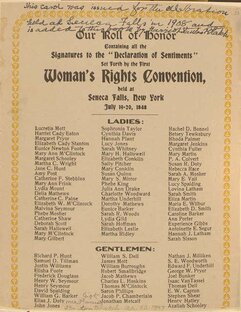 A printed card of the signatories to the Seneca Falls Declaration of Sentiments commemorating the 50th anniversary of the Convention
A printed card of the signatories to the Seneca Falls Declaration of Sentiments commemorating the 50th anniversary of the Convention Female Quakers local to the area organized the meeting along with Elizabeth Cady Stanton, who was not a Quaker. They planned the event during a visit to the area by Philadelphia-based Lucretia Mott. Mott, a Quaker, was famous for her oratorical ability, which was rare for non-Quaker women during an era in which women were often not allowed to speak in public.
The meeting comprised six sessions including a lecture on law, a humorous presentation, and multiple discussions about the role of women in society. Stanton and the Quaker women presented two prepared documents, the Declaration of Sentiments and an accompanying list of resolutions, to be debated and modified before being put forward for signatures. A heated debate sprang up regarding women's right to vote, with many – including Mott – urging the removal of this concept, but Frederick Douglass, who was the convention's sole African American attendee, argued eloquently for its inclusion, and the suffrage resolution was retained. Exactly 100 of approximately 300 attendees both men and women, signed the document.
The convention was seen by some of its contemporaries, including featured speaker Mott, as one important step among many others in the continuing effort by women to gain for themselves a greater proportion of social, civil and moral rights, while it was viewed by others as a revolutionary beginning to the struggle by women for complete equality with men. Stanton considered the Seneca Falls Convention to be the beginning of the women's rights movement, an opinion that was echoed in the History of Woman Suffrage, which Stanton co-wrote.
The convention's Declaration of Sentiments became "the single most important factor in spreading news of the women's rights movement around the country in 1848 and into the future", according to Judith Wellman, a historian of the convention. By the time of the National Women's Rights Convention of 1851, the issue of women's right to vote had become a central tenet of the United States women's rights movement. These conventions became annual events until the outbreak of the American Civil War in 1861.
 RSS Feed
RSS Feed